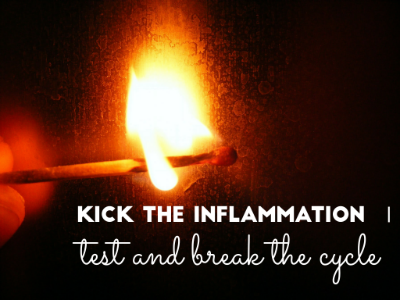Today we are not messing around! Getting to the bottom of inflammation is a critical piece not only of your Fat Loss Formula but also for your health. Inflammation underlies heart disease, diabetes, arthritis, obesity and many other chronic diseases. As we discussed HERE, inflammation levels in your body can contribute to insulin resistance and obesity, independent of how much you eat. Obesity on the other hand is also an inflammatory condition that can keep you in the cycle of fat gain. This cycle of inflammation needs to be broken in order to achieve optimal health.
How do we do it?
Testing
If you could not already tell, I am a test and tweak kind of doctor. I believe that when we have data it is easier for you to achieve the results you want quicker, and with less trial and error.
Tests for inflammation are commonly run through your medical doctor, but these specific tests can be helpful to access the level of inflammation, and even autoimmunity, that you may be experiencing.
Hs-CRP (high sensitivity c-reactive protein)- this is a measurement of systemic inflammation and is associated with cardiovascular disease risk.
ESR (erythrocyte sedimentation rate) – this test measures how quickly your red blood cells fall. The more inflammation stuck to them, the heavier they are and the faster they fall.
25-hydroxyvitamin D– Vitamin D is deficient in many North American’s and should be tested for sufficiency. Vitamin D is the master regulator of immune function so it should be monitored and kept between 75-100ng/ml in most people
ANA (antinuclear antibody)- this is a very general test for autoimmunity. It is not specific for any particular autoimmune disease but if it is positive then more investigation is required.
Okay, so now you know that you are inflamed. What next?
First Steps in Inflammation Treatment
The interventions required to reduce inflammation are vast and personalized, that is the bad news. When it comes to individual treatments NDs look to where the inflammation is manifesting in the body, where it could have originated and treat based on that. Everything from curcumin, to specific probiotics, to glutamine, enzymes, and antioxidants can be used. The good news is there are specific interventions that can be helpful in most people!
Step 1- Get your diet in check.
Gluten, dairy, eggs, nuts, corn, soy and inflammatory oils (such as canola, vegetable oils or deep fried foods) are some of the most inflammatory foods that North American’s eat regularly. Now don’t let me alarm you, not all foods are inflammatory in everyone. I encourage people to begin with an elimination diet which can help you to identify your personal food sensitivities. Most people, as a general rule, benefit from eliminating inflammatory oils, and often people who are trying to break into fat loss will benefit from dairy and gluten elimination as well.
Fiber and anti-oxidants are also an important part of a fat loss diet. 25-30g of fiber, along with richly colored fruits and vegetables can help to improve fat loss(Paniagua, 2016).
Step 2- Up your friendly fats.
Omega 3 fatty acids, and particularly EPA which is an anti-inflammatory Omega 3 fatty acid, can be an important part of an anti-inflammatory intervention. This study is just one of the most recent studies confirming that Omega 3s are an important part of the formula to lower inflammation levels and achieve fat loss success(Paniagua, 2016). I often encourage patients to supplement up to 1500mg of EPA for the best anti-inflammatory results. (Just a note on this one, if you are taking any blood thinning medication then stick to diet recommendations, as this can interact with your meds!)
Okay, so now that you understand where your body is storing fat, have kicked down your insulin levels and have now managed your inflammation, there can’t be much left right? WRONG! There is so much more!
References
Paniagua, J. A. (2016). Nutrition, insulin resistance and dysfunctional adipose tissue determine the different components of metabolic syndrome. World Journal of Diabetes, 7(19), 483–514. http://doi.org/10.4239/wjd.v7.i19.483

